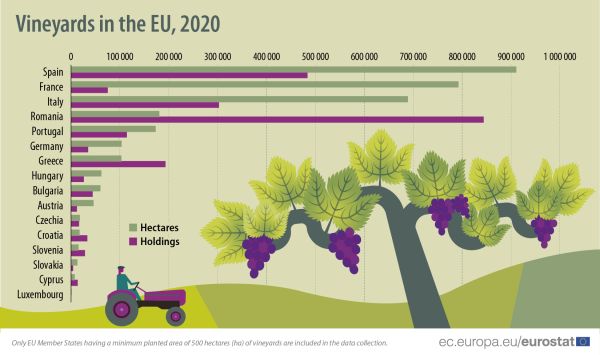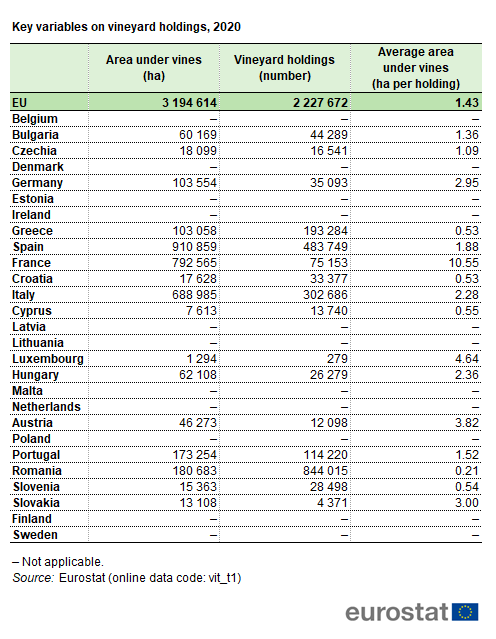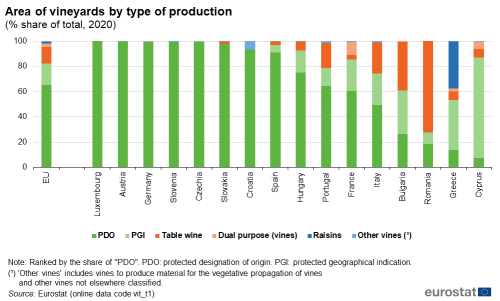Vineyards in the EU - statistics
Data extracted in May 2022
Planned up date: May 2027
(collection of data done every five years)
Highlights
In 2020, vines were grown on 3.2 million hectares in the EU, equivalent to about 45 % of the world’s total wine-growing areas.
There were 2.2 million vineyard holdings for wine in the EU in 2020, the vast majority of which were very small; 83.3 % had less than 1 ha of vineyards.
Spain, France and Italy together accounted for three-quarters (74.9 %) of the area under vines in the EU and about two-fifths (38.7 %) of vineyard holdings in 2020.
The European Union (EU) had 3.2 million hectares of vines in 2020, equivalent to about 45 % of the world’s wine-growing areas[1]. This article describes the vineyards in the European Union (EU) in 2020. The structural statistics on vineyards are a tool for monitoring the market for wine and other grape-based products and are collected every 5 years. The data collection covers the area under vines, the number of wine-grower vineyard holdings as well as other indicators such as the size of the vineyard holdings, the main varieties and age of vines.
Only EU Member States having a minimum planted area of 500 hectares (ha) of vineyards are included in the data collection. A total of 16 Member States are covered[2] representing 99.97 % of the total area under vine in the EU[3]. Holdings producing exclusively table grapes are excluded from this data collection.
Full article
General overview
The total area under vines in the EU was 3.2 million hectares (ha) in 2020, equivalent to 2.0 % of the utilised agricultural area (UAA). In 2020, there were 2.2 million vineyard holdings for wine (hereafter termed ‘vineyard holdings’) in the EU, the vast majority of which were very small; 83.3 % had less than 1 ha of vineyards.
Spain, France and Italy together accounted for three-quarters (74.9 %) of the area under vines in the EU and about two-fifths (38.7 %) of vineyard holdings in 2020. However, Romania had the highest number of vineyard holdings in the EU (0.8 million holdings, equivalent to 37.9 % of the EU total in 2020).
The main vine varieties for red wine accounted for a small majority (52.7 %) of all main vine varieties, with those for white wine accounting for most of the rest (44.6 %). Vines for quality wines dominate EU vineyards; 82.4 % of the area of vineyards in the EU were dedicated to quality wine production in 2020.
Vines in the EU are relatively old; vines over 30 years old in 2020 represented a little over one-third (36.7 %) of the area of the EU’s vineyards in 2020, with a further two-fifths (41.3 %) being accounted for by vines that were between 10 and 29 years old.
The vast majority (82.4 %) of the EU’s vineyards in 2020 were dedicated to the production of grapes for quality wine. Quality wine refers to products of both protected designation of origin (2.1 million ha, equivalent to 65.3 % of the EU’s vineyards) and protected geographical indication (0.5 million ha, equivalent to 17.1 %).
Between 2015 and 2020, there were 257 000 fewer vineyard holdings in the EU, equivalent to a 10.3 % reduction. Most of these holding losses came from the very smallest vineyard holdings; there were 226 000 fewer holdings than in 2015 in the size class with less than 1 ha of vines. There were sharp reductions in the number of vineyard holdings in a number of Member States, but particularly in Portugal (a loss of 98 000 holdings), in Italy (a loss of 78 000 holdings) and in Spain (a loss of 34 000 holdings). Despite these losses, the area of vineyards for wine production remained relatively stable (-1.1 %) between 2015 and 2020.
3.2 million hectares of vineyards in the EU
In 2020, there were 3.2 million hectares of land under vines in the EU. Among the 16 Member States that have more than the threshold of 500 ha of vineyards, Spain (with 0.9 million hectares), France (0.8 million ha) and Italy (0.7 million ha) together accounted for about three-quarters (74.9 %) of the EU’s total area under vines (see Figure 1). Most of the rest of the EU’s vineyards were in Romania, Portugal, Germany and Greece, which each had a further 0.1 million to 0.2 million hectares under vines.
There are a number of regions in the EU that are specialised in wine production. About one-fifth of the utilised agricultural areas of Languedoc-Roussillon in France (21.3 %) and La Rioja in Spain (20.1 %) were planted to vines, and about 15 % in the Fruili-Venezia Guilia region of Italy and Madiera in Portugal. There was widespread regional specialisation in France, Spain, Italy and Portugal (see Map 1 and areas where the share of UAA under vines exceeded 8 %) as well as isolated regions in other Member States, like Wien in Austria (where 11.8 % of UAA was under vines), Attika in Greece (9.4 %) and Rheinland-Pfalz in Germany (NUTS1, 9.2 %).

(% of total utilised agricultural area, 2020)
Source: Eurostat (vit_t1).
2.2 million vineyard holdings in the EU
The EU had 2.2 million vineyard holdings in 2020. A little less than two-fifths (37.9 %) of this EU total were the 0.8 million holdings in Romania, which are typically very small. A further 0.5 million vineyard holdings were in Spain and 0.3 million in Italy, together accounting for one-third (35.3 %) of the EU total (see Table 1 and Figure 2).
The EU’s vineyards are typically small, particularly when compared to the size of other farms that grow crops or raise livestock. The average (mean) size of a vineyard holding in the EU was 1.4 ha in 2020, compared with an average of 15.2 ha (2016) for all holdings in the EU. The smallest vineyards in the EU were in Romania (an average 0.2 ha per vineyard holding), and Croatia, Greece, Slovenia and Cyprus (all about 0.5 to 0.6 ha on average). By contrast, the average size of a vineyard holding in France was 10.5 ha, which was more than double that of the next highest average of 4.6 ha in Luxembourg (see Figure 3).
Across the EU, there were relatively small numbers of holdings with large areas of vineyards; at the level of the EU, 3.2 % of holdings with more than 10 ha of vineyards accounted for a majority (59.2 %) of all vineyards in the EU (see Figure 4). The vast majority of vineyard holdings were very small; 83.3 % had less than 1 ha of vineyards. This distribution was a feature of most Member States; in Slovakia, France, Czechia, Bulgaria, Spain, Germany, Luxembourg, Austria, and Hungary, a majority of the area under vines was on those holdings with more than 10 ha of vineyards and in Italy and Portugal was only a little less than 50 %.
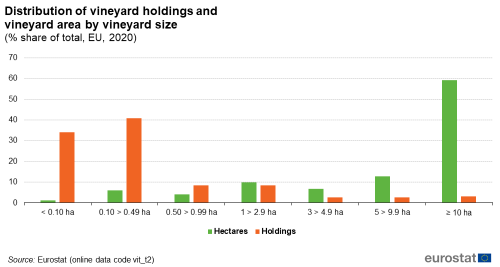
(% share of total, EU, 2020)
Source: Eurostat (vit_t2)
Over half of the area under vines for main vine varieties for red wine
The main vine varieties in the EU accounted for 91.1 % of all the area planted with vines. The share of small (having a total area of less than 500 ha at national level), often regional varieties was 8.9 %. There are over 500 different ‘main vine varieties’[4]in the EU, with as many as 96 main vine varieties in Italy alone.
The main vine varieties for red wine covered 1.5 million ha across the EU in 2020, compared to 1.3 million ha for the main vine varieties for white wine and 0.1 million ha for other colour varieties (or not specified). The red wine varieties accounted for a majority of the vineyard areas in France (63.3 %), Portugal (62.1 %), Cyprus (58.0 %), Bulgaria (55.5 %) and Spain (52.3 %). The white wine varieties accounted for a majority of vines Austria (68.4 %), Slovenia (68.3 %), Germany (68.1 %), Croatia (67.3 %), Hungary (65.8 %), Slovakia (65.0 %), Romania (62.7 %) and Czechia (61.1 %) – see Figure 5. In Spain and Italy, there was a relatively even split between red and white main vine varieties. In Greece, about one-fifth (20.9 %) of vines were for other coloured varieties, particularly for the pink ‘Roditis’ variety.
In 2020, the most cultivated main red varieties in the EU were Tempranillo tinto (13.8 % of all area under main vine varieties for red wine), Merlot noir (11.5 %) and Garnacha tinta (9.5 %). The most cultivated main white varieties were Airen (14.9 % of all area under main vine varieties for white wine), Trebbiano toscano (9.9 %) and Chardonnay blanc (7.8 %).
Most varieties, even the most widely planted, tend to be grown in a relatively narrow geographic spread: for example, Airen is only cultivated in Spain, Tempranillo tinto only in Spain and Portugal and Trebbiano toscano mostly in France and Italy. The key exceptions were Merlot noir and Chardonnay, which were each planted across 14 Member States.
Older vines dominate vineyards in the EU
Across the EU, the age of the vines tends to be above 10 years; 36.7 % of the EU’s vines were older than thirty years in 2020, with a further 41.3 % between 10 and 29 years old (see Figure 6). Very young vines of less than three years old represented just 4.5 % of all vines across the EU in 2020, those between 3 and 9 years old representing 17.5 %. Only in Hungary was the age-spread of vines relatively even (35.5 % under 10 years, 34.4 % between 10 and 29 years old, and 30.1 % over thirty years old).
The share of vines over thirty years old was particularly high in Bulgaria (68.8 %), Romania (65.7 %) and Cyprus (64.7 %). In the case of Romania, the process of replanting stock was well above the EU average, with 12.0 % of vines also under 3 years old. This was not the case in Bulgaria and Cyprus, where the proportion of vines under 3 years old was below the EU average. Germany (7.1 %), Hungary (6.8 %), and Italy (6.5 %) also had relatively high shares of vines under 3 years old.

(% share of total vine area, 2020)
Source: Eurostat (vit_t4)
Vines for quality wines dominate EU vineyards
The type of grapes the vineyards in the EU produce are classified into six different categories (see Table 2 and Figures 7 and 8). Two of the categories used in the classification are considered ‘quality wine’:
- Protected designation of origin (PDO)[5] and
- Protected geographical indication (PGI)[6].
The vast majority of vines in the EU are dedicated to the production of ‘quality wines’; 65.3 % were planted for wines under the PDO classification and a further 17.1 % for wines under the PGI classification in 2020. Only 13.2 % of the EU’s vines were dedicated to table wine.
In Czechia, Germany, Luxembourg, Austria and Slovenia all vines for wine grape production are exclusively for the production of quality wines. The relative shares in Croatia, Spain, Hungary and Slovakia were also above 90 % in 2020 (see Figure 7).
Only in Romania was a majority (72.1 % in 2020) of vines dedicated to the production of table wine. Vines for table wine were also relatively common in Bulgaria (38.7 % of all vines), Italy (24.3 %) and Portugal (20.1 %). Greece was the only Member State with vines dedicated to the production of raisins (dried grapes), and these vines represented 37.4 % of all vines in the country.
Relatively stable vine area in EU between 2015 and 2020 but sharp reduction in vineyard holdings
Between 2015 and 2020, the area of vines in the EU as a whole has remained relatively stable (-1.1 %). However, there was a sharp reduction of 257 000 in the number of vineyard holdings across the EU. Most of these holding losses came from the very smallest vineyard holdings; there were 226 000 fewer holdings than in 2015 in the size class with less than 1 ha of vines.
Between 2015 and 2020, there were sharp reductions in the number of vineyard holdings in a number of Member States, but particularly in Portugal (a loss of 98 000 holdings, although this is also partly due to a change in data source and coverage), in Italy (a loss of 78 000 holdings) and in Spain (a loss of 34 000 holdings) – see Figure 8. The EU area of vines held relatively steady, however, with the increase in vineyard area in Italy (up 38 000 ha, despite the sharp drop in the number of vineyard holdings) largely balancing the losses in Spain (down 30 000 ha) and France (down 10 000 ha). Accompanying the loss of vineyard holdings in Portugal, the area under vines in 2020 was 25 000 hectares less than in 2015.
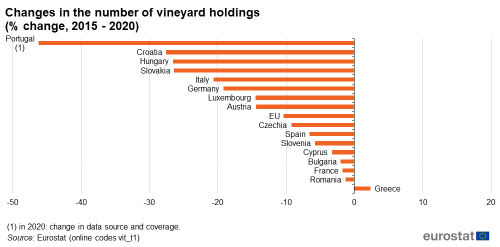
(% change, 2015 - 2020)
Source: Eurostat (vit_t1)
Source data for tables and graphs
Data sources
Statistical surveys on areas under vines
European statistics on the structure and production potential of vineyards have been collected from 1979 onwards. More thorough surveys have been done every ten years (1979, 1989, 1999 and 2009) until 2009. France and Italy conducted the 2009 survey together with the agricultural census in 2010. From 2015 onwards the data are to be extracted every 5 years from the vineyard register.
Since 2011 the statistics on vineyards are covered by Regulation (EU) No 1337/2011. The first data collection under this legislation took place in 2015, and its results are presented in this article.
Previously, EU statistics on vineyards were governed by Council Regulation (EEC) No 357/79 of 5 February 1979 on statistical surveys of areas under vines.
Definitions
Data production threshold – Regulation (EU) No 1337/2011 is applicable to all Member States having a minimum planted area of 500 ha of vineyards. For the variety data only the main vine varieties having an area bigger than 500 ha at national level are included. It is not necessary to report smaller areas.
The areas intended to produce solely table grapes are excluded from the vineyard data collection. If vineyards produce dual purpose grapes ( e.g. for wine and table use) they are included in the Vineyard survey.
Area under vines includes areas:
- in production;
- not yet in production;
- area producing material for vegetative propagation of vines.
The area does not include abandoned areas which are no longer in production and have not been harvested for at least eight years.
Other utilised agricultural area (other than under vines) is not taken into account for size classification.
Protected designation of origin (PDO) designates the name of a product which must be produced within a determined geographical area using recognised and recorded know-how. All products with PDO status must be produced exclusively with grapes from the area in question.
Protected geographical indication (PGI) designates a product with a quality, reputation or other specific features that can be attributed to a determined geographical area. All products with PGI status must be produced with at least 85 % of the grapes coming from the area in question.
Planting year means the first year when the plant has vegetative development after the day when it is installed on its definitive production place.
Context
Structural statistics on vineyards serve for monitoring the market of grape-based and wine products. The Commission needs information on the production potential of vineyards in order to ensure that the Common Agricultural Policy is properly administered.
The main institutional users of vineyards data are DG Agriculture and Rural Development, DG Health and Consumers, DG Environment, the European Parliament, the Court of Auditors and European agencies (e.g. European Environment Agency, European Food Security Agency), as well as national bodies dealing with agriculture, food production, trade in agricultural products and food prices. Economic and social players in the ‘agricultural world’ (enterprises, farms, producer and consumer associations, trade unions, consultancy bodies, private and public research bodies, insurance agencies, etc.) are likewise very important users of vineyard statistics.
The Common Agricultural Policy (CAP) includes provisions for the wine sector. As of 2016, in the wine sector, the planting rights system was replaced by a dynamic planting-authorisation management mechanism. More information can be found on DG AGRI’s site: ‘The reforms of the EU wine market.’
Direct access to
- [https://ec.europa.eu/eurostat/web/products-statistical-books/-/ks-fk-20-001 Agriculture, forestry and fishery statistics — 2020 edition
- Area under vines in the EU down by 15.7% between 1989 and 1999
- Regulation (EU) No 1337/2011 of the European Parliament and of the Council of 13 December 2011 concerning European statistics on permanent crops and repealing Council Regulation (EEC) No 357/79 and Directive 2001/109/EC of the European Parliament and of the Council
- Summaries of EU Legislation: Production of EU statistics for permanent crops
- Summaries of EU Legislation: EU integrated farm statistics
- Commission Regulation (EC) No 436/2009 laying down the detailed rules for the application of Council Regulation (EC) No 479/2008 as regards the vineyard register
DG Agriculture and Rural Development
Notes
- ↑ https://ec.europa.eu/info/food-farming-fisheries/plants-and-plant-products/plant-products/wine_en
- ↑ Belgium, Denmark, Estonia, Ireland, Latvia, Lithuania, Malta, the Netherlands, Poland, Finland and Sweden are below the threshold of 500 ha of vineyards, and are therefore not included in the data collection.
- ↑ In 2010, following the latest agricultural census, there were only 1 030 ha dedicated to wine-growing area in eleven Member States which are below the threshold of 500 ha.
- ↑ In Regulation (EC) No 1337/2011, the "main vine varieties" are only the varieties having an area bigger than 500 ha at national level.
- ↑ Protected designation of origin (PDO) designates the name of a product which must be produced within a determined geographical area using recognised and recorded know-how. All products with PDO status must be produced exclusively with grapes from the area in question.
- ↑ Protected geographical indication (PGI) designates a product with a quality, reputation or other specific features that can be attributed to a determined geographical area. All products with PGI status must be produced with at least 85 % of the grapes coming from the area in question.
